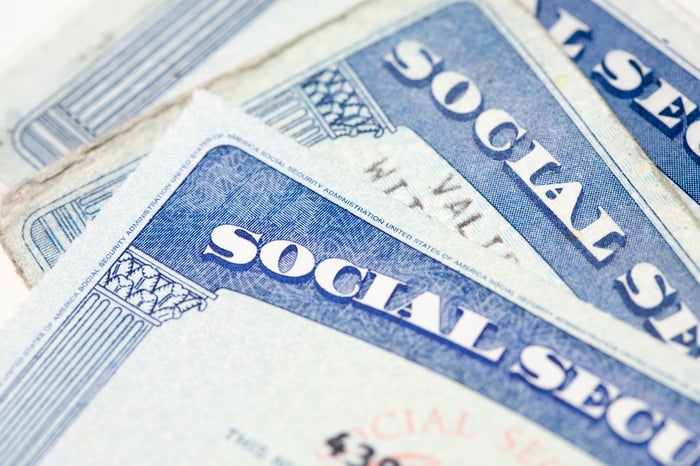Some Social Security Retirees Won't Receive Their 2026 COLA in Full. Are You Among Them?
Key Points
Social Security benefits get a cost-of-living adjustment (COLA) in most years to compensate for the impact of inflation.
It was recently announced that 2026's COLA will be 2.8%.
Some Social Security recipients will see their COLA whittled down for one big reason.
- The $23,760 Social Security bonus most retirees completely overlook ›
When you work full time, the weeks leading up to your year-end performance review can be nerve-wracking. That's because managers typically take that opportunity to share what size raise -- if any -- you'll be getting in the upcoming year.
Similarly, Social Security recipients tend to get antsy when October rolls around because that's the month when the program's cost-of-living adjustment, or COLA, is announced for the coming year.
Where to invest $1,000 right now? Our analyst team just revealed what they believe are the 10 best stocks to buy right now, when you join Stock Advisor. See the stocks »

Image source: Getty Images.
Social Security COLAs are calculated based on the year-over-year changes to the Consumer Price Index for Urban Wage Earners and Clerical Workers (CPI-W) during the months of July, August, and September. For this reason, the Social Security Administration (SSA) has to wait until October each year to calculate the next one.
The SSA was initially scheduled to announce the 2026 COLA on Oct. 15. But due to the government shutdown and a delay in the release of CPI-W data for September, that announcement was postponed until Oct. 24.
Now we know: Retirees will be getting a 2.8% boost to their monthly benefits starting in January. Based on the average monthly benefit today, that amounts to an average increase of about $56 a month.
However, not every senior on Social Security will see their checks rise by the full 2.8%.
Why some Social Security recipients will lose out in the new year
Anyone who receives retirement benefits from Social Security is eligible for the program's upcoming COLA. But some retirees claim Social Security before they're old enough to sign up for Medicare.
Medicare eligibility typically begins at 65, whereas Americans are allowed to claim Social Security as early as 62, albeit at a reduced rate. It's common, however, for seniors who are 65 and over to sign up for Medicare and Social Security at the same time.
While Medicare Part A, which covers hospital care, is typically free for enrollees in terms of premiums, Part B, which covers outpatient care, is not.
There's a standard monthly Part B premium that's updated every year. Seniors who are on both Medicare and Social Security have their Part B premiums deducted from their Social Security benefits automatically.
Currently, the standard Medicare Part B premium is $185 per month. But based on projections by the Medicare Trustees, in 2026, the standard Part B premium could rise by $21.50 to $206.50.
If that nearly 12% increase takes effect, the average Social Security recipient on Medicare would only see their monthly benefit increase by about $34.50, as opposed to $56. That could sting a bit for anyone who's been looking forward to a more generous COLA to give them a little financial wiggle room.
Of course, that $206.50 projection isn't set in stone. It could change. But the general consensus is that the cost of Medicare Part B will increase by a substantial percentage in 2026. So no matter what that increase amounts to specifically, it will likely take an outsized bite out of the upcoming COLA for any Social Security recipient who's enrolled in Medicare.
Know what to expect
It would be natural to take note of the recent Social Security COLA announcement and start crunching numbers based on the monthly benefit you receive. But if you're on Medicare too, you'd be well advised to wait to see what changes are coming to Part B before you start planning tweaks to your budget based on your COLA.
Of course, Part B may not be the only thing that's changing for you in the context of Medicare. Your Part D or Advantage plans could also be getting more expensive.
The good news is that Medicare's open enrollment period is underway, so between now and Dec. 7, you have an opportunity to make changes to your coverage. If you're able to find a less expensive Part D or Medicare Advantage plan, that could help you spend less on Medicare overall, thereby stretching your Social Security checks further.
But all told, it's important to be realistic about what the upcoming COLA will and will not do for your finances, especially if you're enrolled in Medicare. And if you're banking on a more generous raise, you may want to take matters into your own hands instead.
A 2.8% COLA will boost your Social Security checks a bit in the new year even once Medicare hikes are accounted for. But moves like downsizing, going back to work part-time, or adding a few more hours if you already are working part time could have a much more significant impact on your finances.
The $23,760 Social Security bonus most retirees completely overlook
If you're like most Americans, you're a few years (or more) behind on your retirement savings. But a handful of little-known "Social Security secrets" could help ensure a boost in your retirement income.
One easy trick could pay you as much as $23,760 more... each year! Once you learn how to maximize your Social Security benefits, we think you could retire confidently with the peace of mind we're all after. Join Stock Advisor to learn more about these strategies.
View the "Social Security secrets" »
The Motley Fool has a disclosure policy.



